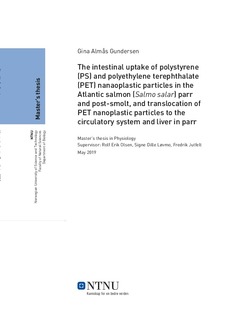| dc.contributor.advisor | Olsen, Rolf Erik | |
| dc.contributor.advisor | Løvmo, Signe Dille | |
| dc.contributor.advisor | Jutfelt, Fredrik | |
| dc.contributor.author | Gundersen, Gina Almås | |
| dc.date.accessioned | 2019-09-16T14:00:30Z | |
| dc.date.available | 2019-09-16T14:00:30Z | |
| dc.date.issued | 2019 | |
| dc.identifier.uri | http://hdl.handle.net/11250/2617037 | |
| dc.description.abstract | Mikro- (20 µm – 5 mm) og nano- (< 20 µm) plast utgjør i dag en stor miljøbekymring gjennom akkumulering i marine miljø. Nyere studier viser også at marine vertebrater og invertebrater inntar plastpartikler og at disse distribueres til organer, potensielt med skadelige effekter på organismens celler og vev. Til tross for økt kunnskap er opptaksmekanismene for plastpartikler over tarmepitelet i fisk ukjent. Denne studien hadde til hensikt å undersøke opptak av polystyren (PS) og polyetylen terephthalate (PET) – nanoplastpartikler over tarmepitel hos par og post-smolt av Atlanterhavslaks (Salmo salar). Studien undersøkte også distribusjon av PET-nanoplastpartikler til sirkulasjonssystemet, lever, hodenyre og milt hos parr. En Ex vivo pilotstudie med bruk av Ussing-kammer bekreftet opptak av polystyren (0,5 µm) og PET – partikler i post-smolt. Et in vivo fôringseksperiment bekreftet videre opptak av ≤ 2 µm PET-nanoplastpartikler i tarmvev og distribusjon til sirkulasjonssystemet og lever hos parr. Partikler distribuert til tarmvev og sirkulasjonssystem ble observert sammen med leukocytter, som kan indikere gjenkjenning og initiering av immunsystemet. Resultatene viser at behovet for videre forskning på de cellulære opptaksmekanismer og effekter i Atlanterhavslaks eksponert for nanoplast er stort, spesielt med tanke på fiskevelferd. | |
| dc.description.abstract | Micro- (20 µm – 5 mm) and nano- (< 20 µm) plastics pose a great environmental concern as it accumulates in marine and aquatic environments. Recently, several studies have also confirmed that marine vertebrates and invertebrates ingest and translocate these plastic particles to various organs with potentially harmful effects. However, knowledge regarding uptake mechanisms over the intestinal epithelium remains unknown. The present study aimed to examine the uptake of polystyrene (PS) and polyethylene terephthalate (PET) nanoplastic particles over the intestinal epithelium in the Atlantic salmon (Salmo salar) parr and post-smolt, and translocation of the latter to the circulatory system, liver, head kidney and spleen in parr. An ex vivo pilot study using the Ussing chamber confirmed intestinal uptake of PS (0.5 µm) and PET nano particles in post-smolt. The in vivo feeding experiment further confirmed intestinal uptake of ≤ 2 µm PET nanoplastic particles and translocation to the circulatory system and liver in parr. Particles translocated to the intestinal tissue and circulatory system were associated with intraepithelial and blood leucocytes, respectively, potentially indicating initiation of the immune system. The results highlight the extended need for further research on cellular uptake mechanisms and effects in the Atlantic salmon exposed to nanoplastic particles and increased knowledge regarding health and welfare consequences. | |
| dc.language | eng | |
| dc.publisher | NTNU | |
| dc.title | Intestinal uptake of polystyrene (PS) and polyethylene terephthalate (PET) nanoplastic particles in the Atlantic salmon (Salmo salar) parr and post-smolt, and translocation of PET nanoplastic particles to the circulatory system and liver in parr. | |
| dc.type | Master thesis | |
